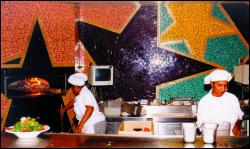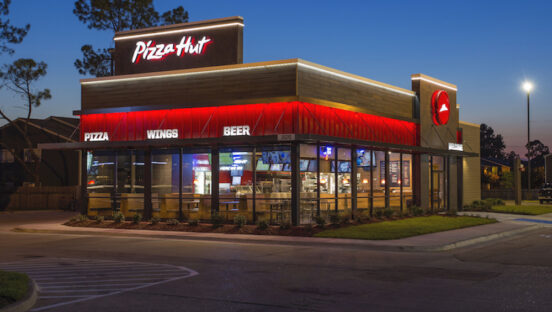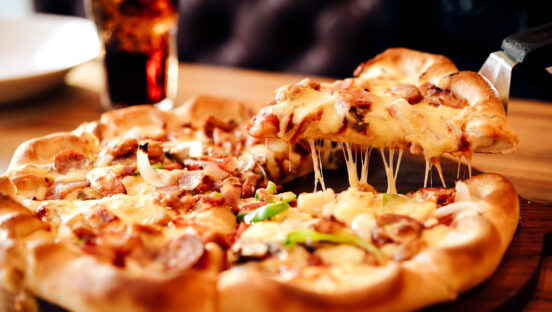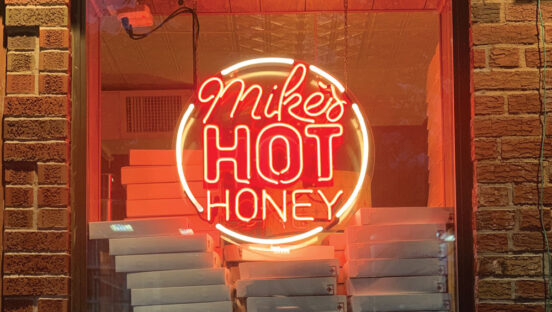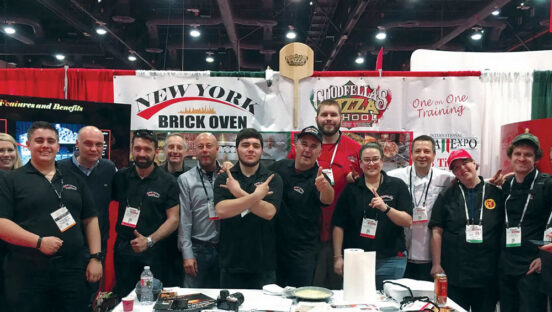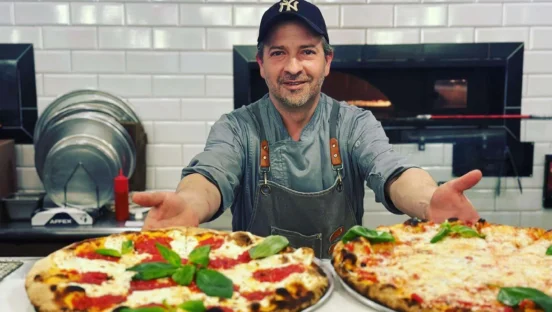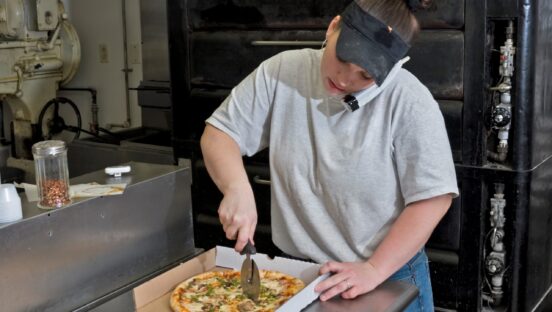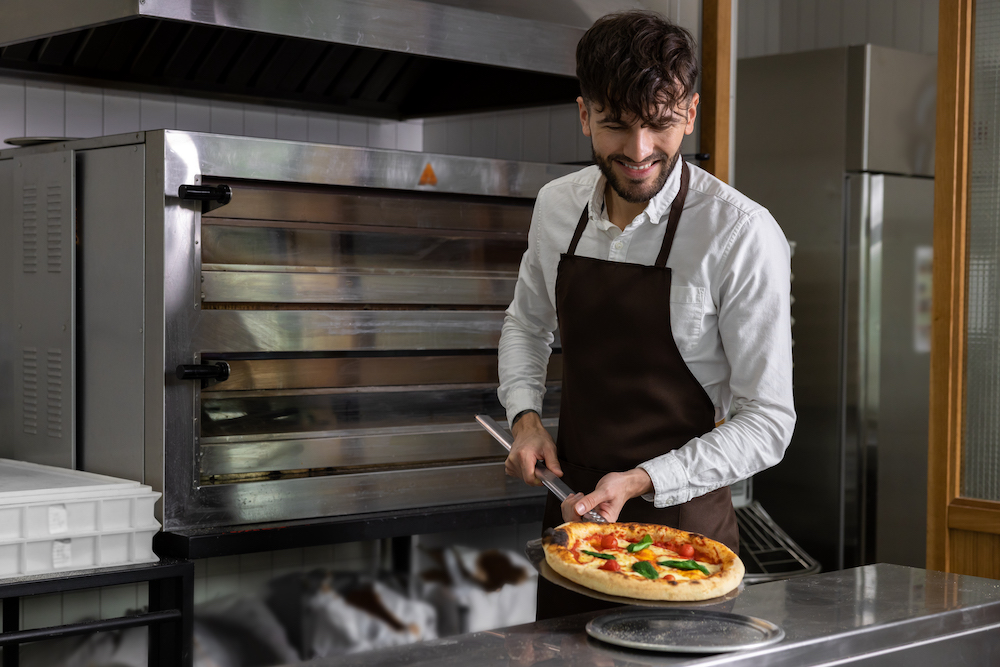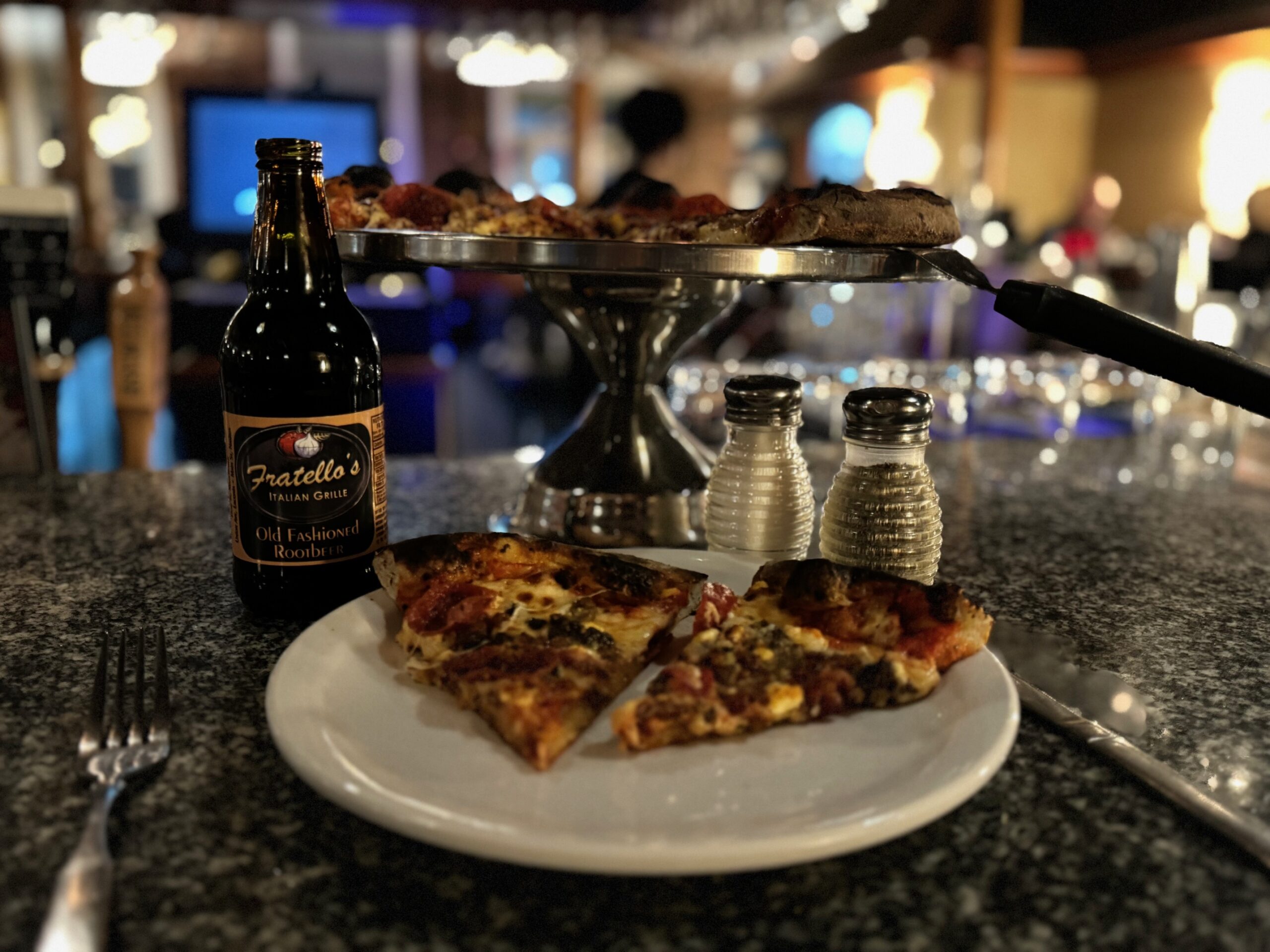It’s your lifeline. It can make or break you, add ambiance or simply be a workhorse. Choosing the right oven is like choosing a spouse. It’s a decision you will have to live with unless you’re willing to deal with the headache of finding a replacement. Well, think of PMQ as your oven dating service.
Space, fuel requirements, capacity and looks are all part of the decision making process when purchasing an oven. An old-style deck oven just won’t do if you have a high volume restaurant and have a high turnover rate for the kitchen staff. A forced air conveyor oven may not give your pizza the taste you want or the right cosmetic appeal for gourmet restaurants that want to use the pizza making process as part of the dining experience.
There are several styles of pizza ovens from which you can choose; conveyors, deck, rotating deck, carousel, infrared or countertop models. Each one has its benefits as well as its disadvantages. I have heard stories of pizza operators purchasing an oven they decided was the one they wanted, but when it came to their operation, it wasn’t what they needed. “Is there that much difference?” you ask. When it comes down to how many pizzas you need to produce an hour to make a profit or what you want your pizzeria to be known for, yes, there is that much difference.
We wanted to break down the pros and cons of each style and provide you with the knowledge to make better decisions when it comes to spending your hard-earned cash. We are providing general information and exceptions can be found for each style of oven listed. The article is intended to be a guide to help you understand the basic principles of each type of oven so you will know what questions to ask and what to look for when purchasing an oven. For specifics, we recommend contacting the manufacturers of ovens you may consider purchasing. Now, let’s look at the subtle differences that differentiate ovens.
Conveyor Ovens
Conveyor ovens are probably the most widely used style of ovens in the pizza industry. Because the speed and airflow is fixed, every pizza is baked the same and consistency is assured. Most pizzerias do the majority of their business in two 3-hour spans during lunch and dinner. The key here is to have an oven that will produce pizzas fast enough to fill orders so those customers can eat, go and be replaced with more customers. Many pizza operators never reach their maximum potential because they do not produce all they can in the two 3-hour spans.
What helps increase the speed of production with these ovens is they are “idiot proof”, so to speak. The pie is made, put in the oven and picked up at the other end. They do not require an experienced pizziolo to peel them in, shuffle them around and know when to remove them when ready. In addition, two pizzas, or more depending on their size, can be put in side-by-side and others lined up to go in right behind them. Basically, they are assembly line ovens that bake consistently every time with minimum effort from the kitchen staff.
One thing to keep in mind when purchasing a conveyor oven is how easy will it be to clean. The best choice is one with easy access to the internal components through doors or by the removal of panels. Ovens that require major disassembly will simply not be cleaned as often, not to mention parts can be lost or put together wrong when reassembling. Let’s face it, you are pizza makers, not mechanics, so make it easier on yourself by choosing a simple design with easy access to the internal components. A dirty oven presents a couple of problems; fire hazards are one and unwanted flavors from old, burning food residue are another. If ovens are not cleaned often, as recommended by the manufacturer, the build up can also cause mechanical failure or premature wear on some of the internal components.
Conveyor ovens have other advantages, too. Unlike most deck ovens, they only require 15 to 20 minutes of preheating time; they hold that temperature throughout the night and cool down quickly when shut down. Conveyors are some the highest capacity ovens on the market today. Recent modifications to the conveyor style include the addition of multiple conveyor belts or split belts that allow for varied cook times in the same cooking chamber.
Stainless steel wire belts used with conveyor ovens. They are used to allow unimpeded heat from the burners reach the bottom of the product. They are also needed because they are belts, which cycle back through the oven. One drawback is that oils and fall off from the toppings can drop through making clean up messy.
There are some disadvantages to conveyor ovens. Among them is the possibility of a shut down resulting from a malfunction of the conveyor belt. If there is a malfunction, the oven will not move the product through the oven and will require that it be shut down, disassembled and repaired. With conveyors that have fans to remove the cold air and move the hot air evenly through the cooking chamber, noise can be an inconvenience, but some manufacturers have worked on this and reduced the noise levels their ovens produce. Cleaning and repair is a difficult and time-consuming endeavor with those lacking easy access to the internal components. Another disadvantage to conveyors is they are generally more expensive.
The trend with conveyor ovens today is for larger ovens. To achieve more production with a conveyor oven you need to go with one that is longer so you can have more pizzas in the cooking chamber at one time. For example: a conveyor with a tunnel that is 18-inches wide x 30-inches long can have two pizzas in at once. If you go with one that is 18-inches wide x 60-inches long you can get four pizzas in at once. Only the belt speed is increased, so the cooking time for each remains the same, but more pizzas are baking in the oven at one time. Instead of baking two pizzas in eight minutes, you are baking four in the same amount of time. Higher production is determined by how many can be baking at once.
Brick, Stone and Deck Ovens
Brick or deck ovens require more effort and experience than the “idiot proof” conveyor styles, but can produce pizzas with exceptional taste. Producing great pizzas with these ovens are more of an art form. The way they cook is very different. Inside the oven, you find a large “deck” made from ceramic tiles, large bricks or sections of stone. The pizza is put in the oven, or “peeled” in, by placing them on large pizza paddles and sliding them insidethe cooking chamber to cook.
These styles of ovens require more experience than other ones. First, you need a cook who will know when it’s time to pull the pizza out of the oven. Because most of these ovens provide heat from one or more areas, such as from the bottom, back or sides, the temperatures may vary in different areas of the oven. In addition, each time a pizza is placed on the deck, the surface area where the pizza sits has the heat, which is stored in the cooking surface’s material, pulled away by the product being cooked on it. This is why you need an experienced person tending the oven. Another advantage to this style is that you can get them as wood-fired, coal-fired, gas or electric ovens, depending on what you want.
The proper way to bake in these ovens is to “shuffle” or “rotate” the pizzas around inside the cooking chamber so that all sides are baked evenly. Each pizza is cooked to perfection with the skill and knowledge of the cook. The taste varies from pizzas cooked in conveyors because the pizza is placed directly on the cooking surface and bakes the bottom crust differently. Another difference in the crust is that the bottom is usually coated with flour or cornmeal to prevent the pizza from sticking to the surface, which adds a different texture, appearance and taste.
Other advantages of brick, stone and deck ovens are price and ease of cleaning. Generally, they cost less to purchase than conveyors. Cleaning is easier because they have fewer moving parts and can be cleaned by simply closing the doors, cranking up the heat, then scrapping and sweeping any remaining residue from the deck.
Deck ovens offer several choices when it comes to the baking surface. Stone baking surfaces have several advantages. Because pizza is best cooked from the bottom up to get a crispy crust and cook toppings, stone works well. Stone holds heat on the surface better than metal, so less heat is lost in cooking. Another advantage to stone is that it absorbs oils and moisture that is released from pizzas making them dryer. Like an old skillet, it becomes seasoned.
Metal surfaces work well because they too cook from the bottom up. The key here is to make sure the metal surface is thick enough (usually four to six inches). Unlike stone, oils and moisture collect on the surface and can end up frying the crust if not cleaned regularly.
Tiles are much like stone. They absorb oils and moisture, but are not as thick. This makes them cheaper to buy, but they do not maintain surface temperatures as well as stone.
So, what are the disadvantages of conventional style ovens? As the workday progresses and the doors are opened and closed to insert, shuffle and remove pizzas, the heat is released from the oven requiring longer cooking times as the day goes on. You need a good cook who will be with you for a while at the helm because he or she will know how the oven bakes at different times and will also know when the pizzas are ready to be moved or removed. An inexperienced cook may remove them prematurely or too late and create inconsistencies in your product, which leaves customers never knowing what to expect. Preheating and cooling times are usually longer also. Another disadvantage is they generally have less capacity than conveyors.
Rotating or Carousel Deck Ovens
These ovens are similar to regular decks. The difference is the deck surface rotates the pizzas and reduces the amount of shifting and skill needed by the cook. Because they reduce the number of times the doors to the cooking chamber are needed to be opened, less heat escapes, thus making them a little more energy efficient than regular deck ovens. These ovens are not for everyone, just those wanting a deck oven with a higher capacity, but with the “idiot proof” system conveyors provide. You still need a skilled cook, but not as skilled as needed for a traditional deck oven. Cleaning is about the same as normal deck ovens. With the higher production they provide comes a higher purchase price.
Fuel Sources for Ovens
Now that you are familiar with the different styles of ovens, let’s look at the different ways you can cook with them. There are several different fuel sources to choose from; wood, gas, coal, electric or infrared.
First, let’s look at wood-fired ovens. Pizzas cooked in wood-fired ovens look and can taste different and are generally darker in color than those cooked in other styles of ovens. Partly because they absorb some of the smoke, depending on the type of wood used, and the bottom crusts tend to be a little crispier because of the intense heat of the cooking stone. Cleaning is easier, too. You can use an ash pan to collect ashes throughout the day, but most are burned away go out the flue. At the end of the night, simply spread the embers across the deck and remove what ashes are left the next morning.
Select the proper wood for cooking. The most popular choices are oak, almond and walnut, but cherry and apple are good choices, too. Never use pine unless you want your pizza to taste like lumber. The wood must also be seasoned properly. Green wood doesn’t burn as hot. You can expect to burn around one and a half cords per month at an average of $350/cord if you run the oven 10 hours a day. Because they take longer to heat, it is usually necessary to keep them fired, even at night. Because they need separate venting, check with the manufacturer about venting requirements if you are considering a wood-fired oven. You will also need to start preheating the oven one to two hours before starting to cook.
As mentioned, this style of oven requires more skill from the cook, but with the right person, the results can be perfect pizzas. You can expect to produce around 100 pizzas per hour and can fit about 12 to 13 12-inch pizzas in the oven at one time. The last consideration is the weight. These ovens tend to be very heavy, which can be a problem without the proper floor support. Coal-fired ovens have many of the same traits as wood-fired ovens. The difference here is you need to have a supplier for coal.
Gas ovens are probably the most popular. Gas burns clean and consistent. They also have faster recovery times. The recovery time is the amount of time it takes to replenish the heat lost from the raw pizza, the door being opened or heat escaping through other areas. Gas also gives off water vapor as it burns, which some operators believes makes a better pizza. There are generally no affects on the taste due to using gas as a fuel source.
Electric ovens, basically, have the same advantages as gas. They do not require additional venting, but can be expensive to operate in high volume operations.
Combination fuel sources offer the best of either gas or electric combined with wood or coal. They are designed to burn coal or wood, which can give pizza that smoke flavor, but also have gas or electric as an auxiliary fuel source. This means they can be simply turned down at night to prevent long preheating times the next day. They also need less wood put in over the course of the day.
Infrared ovens tend to be the most energy efficient. They use infrared heat, which is similar to, but not exactly the same as, microwave technology. Instead of heating food from the inside out, they heat the pan and surfaces around the food and cook from the transmitting energy through infrared waves. The difference in these ovens and microwave ovens is that they have the ability to brown or crisp the crust, but they are the same in that they do not waste energy heating the surrounding air. Another advantage of infrared technology is the ovens radiate less heat into the kitchen and run very quiet.
There are some drawbacks to infrared ovens. One is that there is no air agitation, which means there is no moisture evaporation. Another consideration is the pans you use need to be flat because a warped pan will cause the top surface to cook inconsistently. A characteristic of infrared ovens is they retain most of the moisture when baking, which can be good in keeping flavor.
Arriving in the pizza industry in 1976, impingement technology is among the newest ideas in pizza ovens. These ovens use high velocity air, which strikes the surface at a 90-degree angle. They allow the product to bake faster because they blow off the moisture and cold air from the unbaked pizza. To demonstrate how much the air helps, look at it this way: If you put your arm in a normal conveyor or wood oven to pull a pizza, your arm doesn’t get burned. If you stick your arm in an impinger oven, you can expect an immediate burn.
Construction
Like most everything else, the life of your oven is determined by its construction and maintenance. Here are some tips on what to look for in an oven that will help you find one that will last.
The exterior of nearly all ovens is made of stainless steel. The important part of the construction is on the inside and this is where you need to look for high quality design and material. The internal structure can be made with the material welded, bent, riveted, spot welded, interlocked or bolted. The strongest of these is welded and the weakest is interlocked. While this plays an important role, the actual design of the components also factor into the durability of the oven.
Another thing to look for is the gauge (or thickness) of metal that is used in construction. Stainless steel, angle iron or sheet metal is normally used. Looking at the gauge of the material used for the internal construction will help clue you in on ovens that are made to last. While stainless steel is made to last longer, it is also more expensive. Choose an oven that is constructed of material that is made to last and will stand up to high temperatures, but also look for simplicity. The simplest designs that employ high quality materials and durable construction are usually your best buy.
Air Distribution
Air distribution within the cooking chamber is important, especially when you have several pizzas cooking at one time. Poor air circulation will create uneven heat distribution across the surface of pizzas and cause them to bake unevenly as they pass through the chamber.
The air volume movement can usually be regulated to eliminate cold spots with adjustments to plates or baffles. Like other parts of the oven, you want to look at how the air is adjusted and determine how easy it will be to maintain. Ovens that use overlapping panels to adjust the airflow are usually more difficult to maintain, while baffles tend to be easier. Look at how many parts you have to remove to make the adjustments, clean and maintain. Once again, the simplest design will probably be the best.
Speed seems to be the key factor in ovens according to most oven manufacturers. How do you know when the pizza is done? According to Tom Lehmann, with the American Institute of Baking, pizzas are done only when the internal temperature reaches 206 degrees F. If you are looking at purchasing a new oven, don’t simply go with the fastest, best looking or best price. Our advice is to consider what you need from an oven for your operation, then narrow your choices down to four or five and contact the manufacturers for specific information relevant to your store. Never buy an oven without first cooking one of your pizzas in it. The last thing you want is to be stuck with something you’re not happy with.



